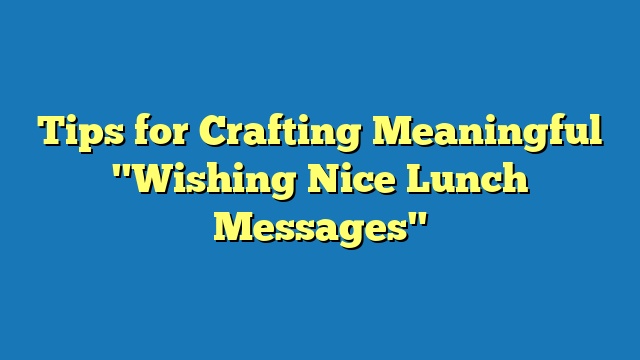A “wishing nice lunch messages” is a cordial expression sent during the midday mealtime, typically conveying well wishes and positive sentiments. The practice of exchanging these messages during lunchtime has become increasingly popular, fostering a sense of camaraderie and goodwill among colleagues and acquaintances.
Wishing nice lunch messages holds several benefits. They can brighten someone’s day, convey appreciation, and strengthen personal and professional connections. Historically, the advent of instant messaging and social media platforms has facilitated the widespread adoption of these messages.
This article delves into the various aspects of wishing nice lunch messages, including their etiquette, impact on workplace culture, and tips for crafting thoughtful and effective messages.
wishing nice lunch messages
Essential aspects of “wishing nice lunch messages” encompass various dimensions, influencing their etiquette, impact, and effectiveness. These key aspects merit consideration to fully grasp the significance and nuances of this practice.
- Thoughtfulness: Crafting messages that convey genuine care and consideration.
- Timing: Sending messages at an appropriate time during the lunch hour.
- Personalization: Tailoring messages to the recipient’s preferences and relationship.
- Brevity: Keeping messages concise and easy to read.
- Positivity: Focusing on uplifting and encouraging messages.
- Cultural sensitivity: Considering cultural norms and customs when sending messages.
- Appropriate language: Using professional and respectful language.
- Consistency: Maintaining a consistent tone and style in messages.
These aspects collectively shape the overall impact and reception of “wishing nice lunch messages.” Thoughtful and well-crafted messages can foster positive workplace relationships, enhance morale, and contribute to a more convivial work environment. Understanding and adhering to these key aspects enables individuals to effectively leverage this practice for its intended purposes.
Thoughtfulness
Thoughtfulness is a crucial component of “wishing nice lunch messages” as it forms the foundation for meaningful and impactful communication. Genuine care and consideration in crafting messages can significantly enhance their reception and contribute to stronger relationships.
When individuals take the time to personalize their messages, it demonstrates that they value the recipient as an individual. Thoughtful messages can acknowledge the recipient’s accomplishments, express appreciation for their work, or simply inquire about their well-being. By going the extra mile to craft thoughtful messages, senders can create a positive and supportive work environment where colleagues feel valued and appreciated.
For example, instead of sending a generic “Have a nice lunch!” message, one could write, “I hope you have a delightful lunch break, [Recipient’s name]. I appreciate your hard work on the recent project.” This personalized message shows that the sender has taken the time to acknowledge the recipient’s efforts and wishes them a specific and enjoyable lunch break.
Thoughtful “wishing nice lunch messages” can also contribute to a more positive and productive workplace culture. When individuals feel appreciated and valued, they are more likely to be motivated, engaged, and collaborative. This, in turn, can lead to improved teamwork, increased productivity, and a more positive overall work environment.
Timing
Timing plays a crucial role in the effectiveness of “wishing nice lunch messages.” Sending messages at an appropriate time during the lunch hour ensures that they are received and appreciated by the recipient. The optimal time to send a lunch message is typically between 12 pm and 1 pm, when most people are taking their lunch break.
Sending messages outside of this time frame may result in them being overlooked or forgotten. For example, sending a lunch message early in the morning may be seen as intrusive, while sending one late in the afternoon may be too close to the end of the workday for the recipient to fully appreciate it.
There are also cultural considerations to keep in mind when determining the appropriate time to send a lunch message. In some cultures, it is considered impolite to send messages during certain times of the day, such as during religious observances or family meals. It is always best to err on the side of caution and send messages during the generally accepted lunch hour.
By sending “wishing nice lunch messages” at an appropriate time, individuals can maximize their impact and ensure that their messages are well-received and appreciated.
Personalization
Personalization plays a vital role in the effectiveness of “wishing nice lunch messages.” By tailoring messages to the recipient’s preferences and relationship, individuals can create more meaningful and impactful communications that foster stronger bonds and a more positive work environment.
When messages are personalized, they demonstrate that the sender has taken the time to consider the recipient as an individual. This can be done by acknowledging the recipient’s accomplishments, expressing appreciation for their work, or simply inquiring about their well-being. By going the extra mile to personalize messages, senders can create a sense of value and appreciation that can significantly enhance workplace relationships.
For example, instead of sending a generic “Have a nice lunch!” message, one could write, “I hope you have a delightful lunch break, [Recipient’s name]. I appreciate your hard work on the recent project.” This personalized message shows that the sender has taken the time to acknowledge the recipient’s efforts and wishes them a specific and enjoyable lunch break.
The benefits of personalization extend beyond individual relationships. In a workplace setting, personalized “wishing nice lunch messages” can contribute to a more positive and productive culture. When employees feel valued and appreciated, they are more likely to be motivated, engaged, and collaborative. This, in turn, can lead to improved teamwork, increased productivity, and a more positive overall work environment.
In conclusion, personalization is a critical component of effective “wishing nice lunch messages.” By tailoring messages to the recipient’s preferences and relationship, individuals can create more meaningful and impactful communications that foster stronger bonds, enhance workplace morale, and contribute to a more positive and productive work environment.
Brevity
In the realm of “wishing nice lunch messages,” brevity plays a pivotal role in ensuring the effectiveness and impact of these communications. Concise and easy-to-read messages are more likely to be received, read, and appreciated by the recipient, leading to stronger relationships and a more positive work environment.
Brevity is critical for “wishing nice lunch messages” because it allows the sender to convey their well wishes in a clear and succinct manner. Long, rambling messages may lose the recipient’s attention and ultimately fail to make the desired impact. By keeping messages concise, senders can ensure that their messages are easily digestible and memorable.
For example, a concise “wishing nice lunch message” could simply read, “Enjoy your lunch break, [Recipient’s name].” This message is clear, concise, and easy to read, conveying the sender’s well wishes without being overly verbose. Conversely, a long and rambling message may lose the recipient’s attention and fail to convey the sender’s intended message.
Practical applications of brevity in “wishing nice lunch messages” abound. By keeping messages concise, senders can:
- Increase the likelihood that their messages will be read and appreciated.
- Make a more positive and lasting impression on the recipient.
- Contribute to a more efficient and productive work environment.
In conclusion, brevity is a critical component of effective “wishing nice lunch messages.” By keeping messages concise and easy to read, individuals can create more meaningful and impactful communications that foster stronger relationships, enhance workplace morale, and contribute to a more positive and productive work environment.
Positivity
In the realm of “wishing nice lunch messages,” the importance of positivity cannot be overstated. Crafting messages that focus on uplifting and encouraging sentiments has a profound impact on the recipient, fostering a sense of well-being, motivation, and connection.
Positivity in “wishing nice lunch messages” serves as a beacon of hope and encouragement, particularly during challenging times. By sending positive messages, individuals can brighten someone’s day, boost their morale, and inspire them to tackle the afternoon with renewed vigor. Simple gestures, such as expressing gratitude, acknowledging accomplishments, or sharing inspirational quotes, can make a significant difference in the recipient’s overall well-being.
For example, instead of sending a generic “Have a nice lunch!” message, one could write, “I hope your lunch break is filled with joy and laughter. Remember, you’re capable of achieving anything you set your mind to.” This positive message not only wishes the recipient a pleasant lunch break but also provides a boost of encouragement and motivation.
The practical applications of positivity in “wishing nice lunch messages” are far-reaching. By focusing on uplifting and encouraging messages, individuals can:
- Create a more positive and supportive work environment.
- Boost the morale and motivation of colleagues.
- Foster a sense of camaraderie and connection.
In conclusion, positivity is an essential component of effective “wishing nice lunch messages.” By focusing on uplifting and encouraging sentiments, individuals can create more meaningful and impactful communications that have a positive ripple effect on the recipient and the workplace as a whole.
Cultural sensitivity
Within the realm of “wishing nice lunch messages,” cultural sensitivity plays a pivotal role in ensuring that messages are well-received and respectful of the recipient’s background and beliefs. By considering cultural norms and customs, individuals can avoid misunderstandings and create more meaningful and inclusive communications.
- Appropriate language: Choosing language that is respectful and non-offensive to the recipient’s culture. For example, avoiding slang or idioms that may not be understood or appreciated.
- Tone and style: Adapting the tone and style of the message to align with the recipient’s cultural expectations. For instance, using formal language in cultures where respect for authority is highly valued.
- Timing and frequency: Sending messages at appropriate times and with a frequency that is respectful of the recipient’s cultural norms. For example, avoiding sending messages during certain religious observances or family meals.
- Symbols and imagery: Using symbols and imagery that resonate with the recipient’s culture. For example, including traditional symbols of good luck or prosperity in a lunch message.
By incorporating cultural sensitivity into “wishing nice lunch messages,” individuals can demonstrate their respect for diversity, foster a more inclusive work environment, and build stronger relationships with colleagues from different cultural backgrounds.
Appropriate language
Within the context of “wishing nice lunch messages,” employing appropriate language is paramount to conveying respect and professionalism. Well-chosen words and phrases demonstrate a sender’s consideration for the recipient’s cultural background, fostering a positive and inclusive work environment. Inappropriate language, on the other hand, can create misunderstandings, offense, and damage relationships.
Consider the following real-life example: A colleague sends a lunch message that includes slang or colloquialisms that are unfamiliar to the recipient. This can lead to confusion and may create an awkward or uncomfortable situation. Conversely, a message that uses clear, respectful language will be well-received and appreciated, regardless of the recipient’s cultural background.
The practical significance of using appropriate language in “wishing nice lunch messages” extends beyond individual interactions. In a diverse workplace, it helps create a sense of unity and belonging. When employees feel respected and valued, they are more likely to be engaged and productive. This, in turn, contributes to a more positive and successful work environment.
Consistency
Within the realm of “wishing nice lunch messages,” consistency plays a vital role in establishing a sender’s credibility, building rapport with the recipient, and fostering a sense of professionalism. Maintaining a consistent tone and style in messages ensures that the sender’s intentions and sentiments are conveyed clearly and effectively, avoiding confusion or misinterpretation.
- Formal or Informal Language: Determine whether the message will adopt a formal or informal tone, ensuring alignment with the sender’s relationship with the recipient and the workplace culture.
- Voice and Perspective: Establish a consistent voice and perspective throughout the message, whether it is written in the first person (“I”) or third person (“Your lunch break”).
- Length and Structure: Maintain a consistent length and structure for lunch messages, ensuring that they are concise, easy to read, and visually appealing.
- Grammar and Spelling: Pay attention to grammar and spelling, avoiding errors that can detract from the message’s professionalism and impact.
Maintaining consistency in “wishing nice lunch messages” goes beyond adhering to specific rules or guidelines. It is about creating a recognizable and reliable communication style that reflects the sender’s values and intentions. By doing so, senders can establish a strong foundation for building and maintaining positive relationships with colleagues and clients alike.
Frequently Asked Questions About Wishing Nice Lunch Messages
This section addresses commonly asked questions and clarifies essential aspects of “wishing nice lunch messages” to enhance understanding and effective implementation.
Question 1: What is the purpose of sending “wishing nice lunch messages”?
Sending “wishing nice lunch messages” aims to express goodwill, appreciation, and support to colleagues or acquaintances during their lunch break. These messages serve as a simple yet effective way to foster positive relationships and create a more convivial work environment.
Question 2: What are the benefits of sending “wishing nice lunch messages”?
Sending “wishing nice lunch messages” offers several benefits, including boosting morale, strengthening connections, and promoting a culture of gratitude and positivity in the workplace. These messages can also contribute to increased job satisfaction and overall well-being.
Question 3: What should be included in a “wishing nice lunch message”?
An effective “wishing nice lunch message” typically includes a brief expression of well wishes, such as “Enjoy your lunch!” or “Have a relaxing lunch break.” Additionally, consider personalizing the message with a specific compliment or acknowledgment of the recipient’s accomplishments.
Question 4: What is the appropriate length for a “wishing nice lunch message”?
“Wishing nice lunch messages” should be concise and easy to read. Aim for a length of around 20-50 words to ensure that the message is impactful without being overwhelming.
Question 5: When is the best time to send a “wishing nice lunch message”?
The optimal time to send a “wishing nice lunch message” is typically between 12 pm and 1 pm, when most people are taking their lunch break. Sending messages outside of this time frame may result in them being overlooked or forgotten.
Question 6: What are some creative ways to send “wishing nice lunch messages”?
In addition to sending text messages, there are various creative ways to convey “wishing nice lunch messages.” Consider sending a personalized e-card, leaving a handwritten note on their desk, or even sending a small treat to their office. By thinking outside the box, you can make your lunch messages more memorable and engaging.
In summary, “wishing nice lunch messages” are a simple yet effective way to foster positive relationships, boost morale, and create a more enjoyable work environment. By following these frequently asked questions, you can craft and send thoughtful and impactful lunch messages that will be appreciated by your colleagues.
Transitioning to the next article section, we will explore additional tips and strategies for composing effective “wishing nice lunch messages” and explore their wider implications in the workplace.
Tips for Sending Effective Lunch Messages
This section provides actionable tips for composing effective “wishing nice lunch messages” that foster positive relationships and create a more enjoyable work environment. By incorporating these tips into your lunch messaging, you can craft meaningful and memorable messages that are sure to be appreciated.
Tip 1: Personalize Your Message: Tailor your message to the recipient’s preferences and relationship. Mention a specific accomplishment, express appreciation for their work, or acknowledge a shared interest.
Tip 2: Be Concise and Clear: Keep your message brief and easy to read, ensuring that your well wishes are conveyed clearly and effectively.
Tip 3: Use Positive and Uplifting Language: Focus on positive and encouraging sentiments that can brighten the recipient’s day and boost their morale.
Tip 4: Send at the Right Time: Send your message during the typical lunch hour, between 12 pm and 1 pm, to ensure that it is received and appreciated.
Tip 5: Be Consistent: Maintain a consistent tone and style in your lunch messages to establish credibility and build rapport with the recipient.
Tip 6: Proofread Before Sending: Take a moment to proofread your message for any errors in grammar or spelling, ensuring that your message is professional and polished.
Summary: By following these tips, you can craft thoughtful and effective “wishing nice lunch messages” that are tailored to the individual recipient, leave a positive impression, and contribute to a more positive and supportive work environment.
Transition: These tips provide a solid foundation for sending meaningful lunch messages; however, to maximize their impact, it is important to consider the wider implications of these messages in the workplace. The next section will explore the positive effects that “wishing nice lunch messages” can have on workplace culture and employee well-being.
Conclusion
In conclusion, “wishing nice lunch messages” extend beyond simple gestures of politeness; they play a vital role in fostering positive workplace relationships and enhancing overall well-being. By incorporating thoughtful personalization, maintaining a consistent tone, and adhering to cultural norms, individuals can craft meaningful messages that leave a lasting impact.
Key insights from this article highlight the power of “wishing nice lunch messages” in building rapport, boosting morale, and creating a more inclusive and supportive work environment. These messages serve as a catalyst for fostering a sense of community and belonging, which can translate into increased productivity, creativity, and job satisfaction.
As we continue to navigate the evolving landscape of workplace communication, it is imperative to recognize the significance of “wishing nice lunch messages.” By embracing these simple yet impactful practices, we can cultivate a culture of positivity, appreciation, and respect that ultimately benefits both individuals and organizations.









Tips for Using "Template by Kevin Crafts" Comments for Meaningful Online Discussions